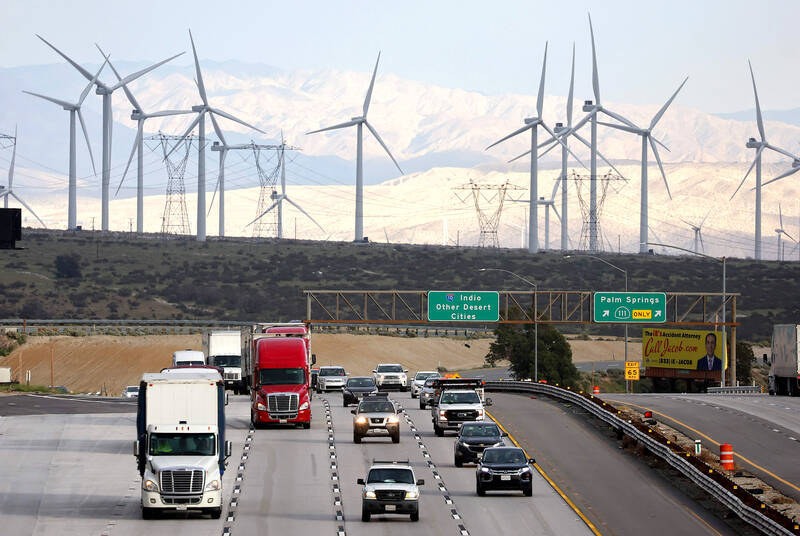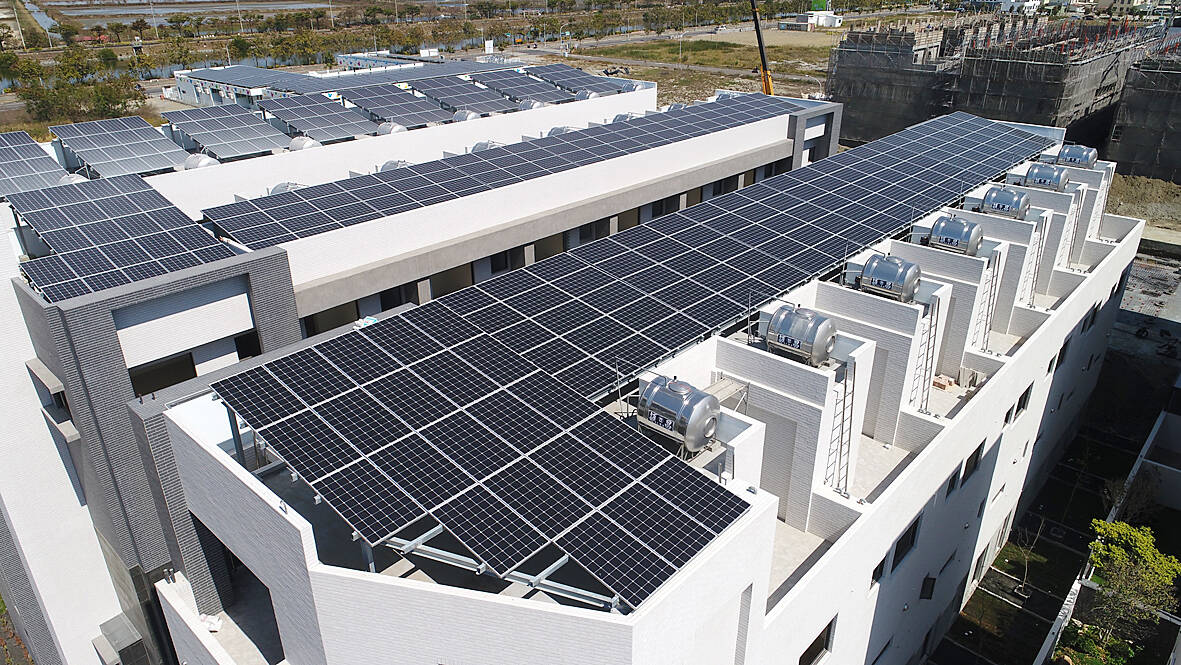Clean energy has become so inexpensive, and climate policy aspirations so common, that together they can potentially lower projected global warming to 1.7°C above pre-industrial levels in 2100, according to the International Energy Agency (IEA).
In a research note published Thursday last week, the IEA stressed that time is running out to avoid the worst effects of climate change. Despite a temporary drop at the height of the pandemic in 2020, global energy-related carbon dioxide emissions rose to a record high of 36.8 billion metric tons in 2022, it said. “The window to a credible pathway towards limiting warming to 1.5°C in 2100 is therefore rapidly closing,” the authors wrote, referring to the Paris Agreement’s stretch goal for containing global temperature rise.
The report’s release coincides with the Major Economies Forum in Washington, which will be attended by countries responsible for 80 percent of global gross domestic product and greenhouse gas emissions. US President Joe Biden used the platform to drum up ambition for more aggressive pollution cuts and more finance to help developing countries build clean infrastructure.

Photo: AFP 照片:法新社
The IEA outlined four necessary thrusts of immediate policy and investment that are needed to prevent dangerous global warming by 2100. Its major conclusions assumed that governments will completely meet all their climate pledges on time — even though “limited policies are to date in place to deliver on them,” a United Nations science panel recently wrote.
First, the energy sector needs to generate more electricity with clean sources, ramp up efficiency and electrify gas-guzzlers such as vehicles and home boilers. By 2030, renewable energy installations need to triple from the record 275 terawatt-hours deployed in 2022. Electric cars, which made up 14% of sales last year, need to win 60% of market share by the end of the decade.
Countries must eliminate deforestation by 2030, as 145 of them pledged to do at UN climate negotiations in Glasgow in 2021. Agriculture, forestry and other land uses make up about a fifth of greenhouse gas pollution, mostly from methane and nitrous oxide.

Photo courtesy of Tainan City Government 照片:台南市政府提供
Non-CO2 greenhouse gases from industry and agriculture must fall at least as fast as planned in the 2016 UN pact reached in Kigali, Rwanda, which targets refrigerant gases that trap heat in the atmosphere.
Finally, the IEA said that countries must move faster to install carbon-capture and storage infrastructure for polluting industrial facilities and build operations to suck CO2 directly out of the air. The 300 million metric tons of CO2 that is projected to be captured in 2030 must rise fourfold by 2100 in the IEA’s most aggressive net-zero scenario.
(Bloomberg)
國際能源署的資料顯示,清潔能源已變得很便宜,對氣候政策的期待也已很普遍,這些因素加起來,有可能達到預期目標,將全球暖化在2100年降到比工業化前的溫度高攝氏1.7度。
國際能源署在上週四發布的一份研究報告中強調,避免氣候變化最糟結果的時間不多了。報告說,2022年全球與能源相關的二氧化碳排放量升至368億公噸的歷史新高,即便在2020年疫情最嚴重時暫時下降。「因此,通往2100年升溫不超過攝氏1.5度之可靠途徑的窗口正迅速關閉」,該報告寫道。2100年升溫不超過攝氏1.5度,是《巴黎協定》遏制全球氣溫上升的延伸目標。
該報告的發布適逢主要經濟體論壇在華盛頓召開,出席該論壇的國家,其國內生產總值與溫室氣體排放量佔全球總量的80%。美國總統喬‧拜登利用該論壇平台鼓吹更積極地減少污染,以及提供更多資金以幫助發展中國家建設清潔基礎設施的雄心。
國際能源署概述了四項即時政策和投資的必要目標,以便能夠在2100年前避免危險的全球暖化。其主要結論假設各國政府將按時完全履行其所有氣候承諾—儘管「迄今他們為達到此目標所制定的政策有限」,一個聯合國科學小組最近寫道。
首先,能源部門需要以清潔能源生產更多電力、提高效率,並為汽車和家用鍋爐等耗油量大的設備供電。到了2030年,再生能源裝置需要比2022年部署的創紀錄的2,750億度電增加兩倍。電動汽車去年佔銷售額的14%,到了2020年代晚期,市占率要達60%才行。
各國必須在2030年之前杜絕森林濫伐,有145個國家在2021年格拉斯哥聯合國氣候談判中承諾做到這一點。農業、林業和其他土地利用約佔溫室氣體污染的五分之一,這些溫室氣體主要是甲烷和一氧化二氮。
工業及農業產生的非二氧化碳溫室氣體,必須至少依2016年聯合國在盧安達基加利達成的協議中所計劃的速度下降,該協議所針對的是在大氣中吸收熱能的冷媒。
最後,國際能源署表示,各國必須加快行動,為污染工業設施安裝碳捕獲及儲存的基礎設施,並建造設施,直接從空氣中吸除二氧化碳。在國際能源署最積極的淨零情景下,預計到2030年要補獲的3億公噸的二氧化碳,到了2100年,必須增加四倍。
(台北時報林俐凱編譯)

Autism spectrum disorder (ASD) is a neurological and developmental condition marked by disruptions in brain-signaling that causes people to behave, communicate, interact and learn in atypical ways. Autism diagnoses in the US have increased significantly since 2000, intensifying public concern over what might contribute to its prevalence. Here is what you need to know. HOW IS AUTISM DIAGNOSED? There are no objective tools for diagnosing autism, such as blood tests or brain scans. Instead, diagnoses are made based on observations and interviews. The term “spectrum” reflects the wide range of possible manifestations. Some people with ASD might have good conversation skills, while others might

A: When is the Lantern Festival? B: The festival is celebrated on the 15th day of the first month of the lunar calendar, which fell on Feb. 12 this year. A: Oh no! Did I miss the 2025 Taipei Lantern Festival? B: Yes, you did. But you can still go to the 2025 Taiwan Lantern Festival in Taoyuan, which will run until this Sunday. A: Let’s go admire the exuberant lanterns. A: 元宵節到底是哪一天? B: 就是農曆1月15日啊,今年則落在國曆2月12日。 A: 喔不,我是不是錯過了2025台北燈節? B: 是的,但你還可以去桃園的2025台灣燈會,活動將持續至週日。 A: 那我們去欣賞豐富的花燈秀吧! (By Eddy Chang, Taipei Times/台北時報張聖恩)

Every February, the small town of Ptuj in Slovenia comes alive with the vibrant celebration of its famous carnival. This festival, with its deep historical roots, is a cherished tradition where local residents come together to ward off the winter cold and embrace the arrival of spring. Participants dress up in furry costumes, transforming into kurenti, mythical monsters believed to drive away evil spirits and bring good fortune for the new year. Although the exact origins of the Ptuj carnival remain a mystery, it is firmly rooted in ancient Slavic and Illyrian cultures. The modern form of the carnival

A: What’s the theme of the 2025 Taiwan Lantern Festival’s main lantern? B: The theme is “Paradise,” and the main lantern is a snake-shaped “infinity” symbol that features a lighting show every half an hour. A: Cool, I heard that there are over 300 lanterns. B: There are even giant lanterns in the shape of Pikachu and some other popular Pokemon characters. A: Let’s go now. A: 2025台灣燈會主燈的主題是什麼? B: 主題是「無限樂園」!主燈的造型則是蛇形的數學「無限號」,主燈每半小時還有一次燈光秀。 A: 酷喔,聽說總共有300多件花燈作品。 B: 甚至還有皮卡丘和其他熱門寶可夢角色的巨型花燈呢。 A: 哇我們現在就出發吧! (By Eddy Chang, Taipei Times/台北時報張聖恩)